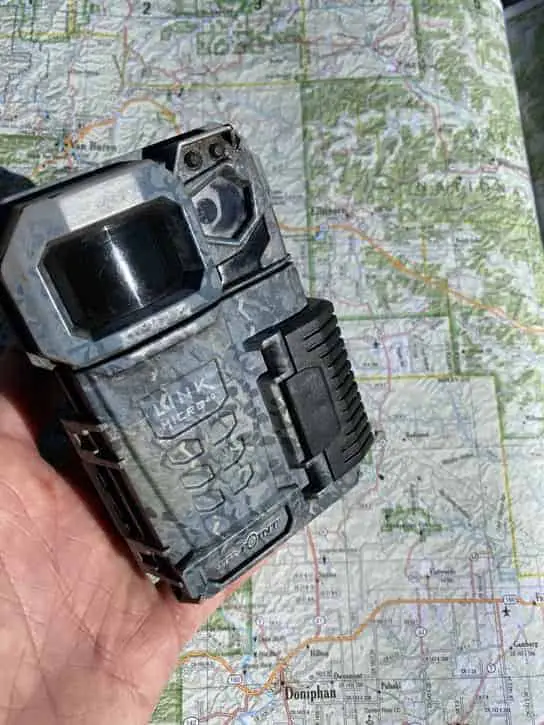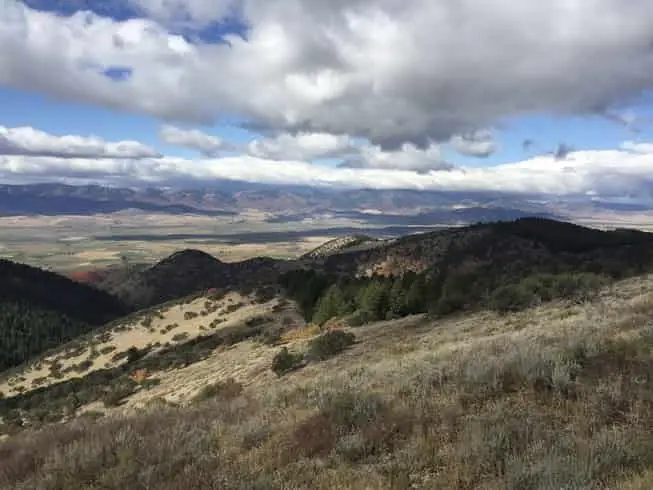Many states allow trail cameras on public land that is not indicated as “specialized” land. But which ones allow trail cameras to be installed on public land?
It is legal to put trail cameras on public land, but not every state will allow it. Several states have special restrictions for the use of trail cameras, one has them altogether outlawed, and some allow them legally without restrictions.
In this article, we will examine the laws in each state as well as the best tips for using trail cameras and how trail cameras are viewed as far as fair chase practices.

Table of Contents
- States That Allow Trail Cameras on Public Lands
- Best Tips for Setting Up and Using Trail Cameras on Public Land
- A Look at Fair Chase
- Conclusion
States That Allow Trail Cameras on Public Lands
Below is a chart of all 50 states and whether or not it is legal to have trail cameras on land listed as “public” and also any special restrictions each state has for the use of trail cameras.
| State | Trail Cameras Legal? | Additional Details |
| Alabama | Yes | |
| Alaska | Yes | Cameras that connect to the internet are restricted. |
| Arizona | No | |
| Arkansas | Yes | |
| California | Yes | |
| Colorado | Yes | Cameras that connect to the internet are restricted. |
| Connecticut | Yes | |
| Delaware | Yes | |
| Florida | Yes | |
| Georgia | Yes | |
| Hawaii | Yes | |
| Idaho | Yes | |
| Illinois | Yes | |
| Indiana | Yes | |
| Iowa | Yes | |
| Kansas | Yes | |
| Kentucky | Yes | Restricted during the off-season. |
| Louisiana | Yes | |
| Maine | Yes | |
| Maryland | Yes | |
| Massachusetts | Yes | |
| Michigan | Yes | Restricted during the off-season. |
| Minnesota | Yes | Restricted during the off-season. |
| Mississippi | Yes | |
| Missouri | Yes | Must be placed away from major roadways and trails. |
| Montana | Yes | Restricted during the off-season. |
| Nebraska | Yes | |
| Nevada | Yes | Restricted during the off-season. |
| New Hampshire | Yes | Restricted during the off-season. |
| New Jersey | Yes | |
| New Mexico | Yes | |
| New York | Yes | |
| North Carolina | Yes | |
| North Dakota | Yes | |
| Ohio | Yes | |
| Oklahoma | Yes | |
| Oregon | Yes | |
| Pennsylvania | Yes | |
| Rhode Island | Yes | |
| South Carolina | Yes | |
| South Dakota | Yes | |
| Tennessee | Yes | Equipment must be checked and maintained every 24 hours. |
| Texas | Yes | |
| Utah | Yes | Restricted during the off-season. |
| Vermont | Yes | |
| Virginia | Yes | |
| Washington | Yes | Restricted during the off-season. |
| West Virginia | Yes | |
| Wisconsin | Yes | |
| Wyoming | Yes | Restricted during the off-season. |
Best Tips for Setting Up and Using Trail Cameras on Public Land
Trail cameras can be an excellent tool for use in hunting and scouting. However, if you aren’t setting your trail cameras up in the right way and in the right spots, they can be pretty much useless.
Finding the Perfect Location To Set Up a Trail Camera
One of the most important things when it comes to setting up a trail camera is the location. You need the best location to catch the best images for you.
You’ll want to find a location you can enter and leave easily without causing much noise or disruption in the area. Whatever game you’re hunting is more likely to notice the human disturbance of the site and not the actual camera itself.
Do not touch the camera or its housing with bare hands or the area around the camera, as this is an almost absolute deterrent to wildlife. It’s best to spray a scent-blocker on the camera and housing to avoid this issue just in case.
You should not just trust the manual included with your camera, as most manuals don’t give you proper advice. For example, most manuals tell you to place your camera much lower than you should.
Cameras are better placed higher up at least 5’ (1.5 m) from the ground to avoid being triggered by grass or weeds blowing in the wind.
You may also want to consider the type of tree you place your camera on. For example, if scouting in bear country…place your camera at least 8-10 feet high, angled downward, and put it on a tree that is too small for a bear to climb.
This will reduce the chances of a curious bear attacking and damaging your trail camera.
Make sure your camera is set up off of a trail. You should never set up a camera directly on a trail (for scent reasons), and in some states, it’s even illegal to do so. Go into thicker forest areas and brush for the best results but remember to pick a spot you can get in and out of quickly.
How Often Should You Check Your Cameras?
Unfortunately, not all states allow this type of technology to be used, so we’ll be looking at best practices for cameras that you must physically check yourself.
You should check your cameras more than once a year. However, you’ll want to check them no sooner than about once a month. But weekly is too soon. Some trail cameras will send your pictures directly to your phone.
It can be so tempting to check your trail cameras as often as possible to see what’s going on, but this is a bad idea. The more you check the cameras, the less you’ll get out of it over time because the wildlife in the area will become alert to your repeated presence.
Also, in states like California, it is required to attend to your equipment every 24 hours, so don’t forget to keep this in mind as well. Some states do not allow the use of cameras prior to hunting season.
If you are able to, it’s best to check your cameras every two weeks if you can set them up before the season. Once the season has started, you can check more than once a week. The best advice is to check as little as possible and spend as much time as you can away from the area where you set up your cameras.
Don’t forget when you check your cameras to bring a card reader. This way, you can check your pictures quickly while you’re there and adjust the angle and position of your camera if there are any issues.
Using Bait at Your Trail Camera Locations (On Private Land)
You can get a much better quality of images when you bait your trail camera locations.
This is not allowed in some states and areas, so make sure you’re in the right before you attempt to bait your camera!
What bait is best to use?
Most suggest using a mineral block or corn as bait as these both are very popular for bringing wildlife to your cameras, especially deer.
Baiting your camera will also help you to see which direction the animal is using to come to your camera’s bait as well as which direction they leave. You can use this information to set up more cameras in those directions if you wish.
Optimizing Your Trail Camera Equipment
There are a couple of fears most have when setting up a trail camera.
The first and one of the biggest fears depending on your area is theft. Trail cameras are not cheap, and it just takes a lack of security to lose your camera to anyone walking through the area you set it.
The next and most common issue people face when using trail cameras is battery life. How are you supposed not to check your cameras too often but also keep them on and working?
How do you keep people from stealing your cameras? The answer to this is simple, and that is to use a powerful lock. The best equipment you can use to prevent theft is an adjustable locking cable or security box.
These are necessary investments to avoid loss. However, locks only keep honest people honest. Anyone who wants to steal your things will find a way to do so very quickly.
As far as battery life, there are a number of ways to optimize how long your camera stays on. The best batteries for a trail camera are either long-lasting alkaline batteries or lithium-ion batteries. Small solar panels are the perfect option to keep your camera on as long as you want without having to revisit more often than you need to.
These require a bit more effort, but the result is well worth it in the long run because you never have to worry about your batteries dying.
How To Change Up Your Strategy for Different Times of the Year
Not every placement of every trail camera will give you optimal images throughout the year. It’s best to start in spring if you are able. This way, you can attract animals to your cameras using mineral blocks and determine the size of herds and travel routes most easily.
Finding food plots or setting up your own baited areas rich in food will be the best way to find the most deer during the summer. Also, if you are searching for a bigger game, following the deer is always a good idea because they are your bigger game’s food source.
Follow the food source of the animal you will find the animal you’re looking for. The summer is also an optimal time to set up near a primary water source. Wildlife will be spending much more time near the water in the hottest months.
In the fall, you will need to change locations.
This is because the environment is changing, food sources are moving, and leaves are falling, which changes how covered areas are. In these times, animals will find new areas to eat and sleep, and you’ll have to start from scratch in a way like you did in the spring.
At the end of the year, you can use the information you have found throughout the year to determine many things:
- What types of animals have you found?
- How many does?
- How many bucks?
- Has the herd grown or decreased?
All of this information is important both now and in the future.

A Look at Fair Chase
Some of you may not know what fair chase is at all, and that’s completely fine.
However, there is a debate about a fair chase and how trail cameras factor into this. One of the main factors why some states have illegalized the use of trail cameras, whether all the time or just for the off-season, is due to fair chase.
This is the only reason trail cameras are restricted at all for use on public land.
It’s only recently that trail cameras have come into play with takes of fair chase due to the positions of Pope-Young and Boone and Crockett. These two organizations released a joint statement on the use of trail cameras that got entire communities talking about the subject of how they affect fair chase.
Let’s take a look at them now.
Boone and Crockett’s Position on Fair Chase
Fair chase is defined as “the ethical, sportsmanlike, and lawful pursuit and taking of any free-ranging wild game animal in a manner that does not give the hunter an improper or unfair advantage over the game animals.” (Boone and Crockett)
In most states where trail cameras are legal or lightly restricted, there has been a bill to ban them at one time or another.
The important part of fair chase is when it comes to scoring. Hunters can only have an animal scored by signing a fair chase affidavit. If you aren’t interested in scoring, then fair chase doesn’t make as much of a difference to you.
Simply put, a fair chase implies that an animal was taken with a fair advantage on both sides. The animal should have a way of escape. Most fair chase violations are apparent to most hunters who are interested in scoring. Some examples are shooting at an animal from behind a fence or spotlighting an animal at night.
Anything that seems to give someone a much higher, much more unfair advantage.
Pope-Young’s Position on Fair Chase
Pope-Young states in no uncertain terms, “Fair Chase shall not include the taking of animals…by the use of electronic devices for attracting, locating or pursuing game or guiding the hunter to such game.” (Pope-Young)
This statement has caused a wide variety of reactions, as it’s very much open to interpretation.
Many everyday practices would also technically violate this rule that no one seems to be up in arms about. For example, many hunters go out together and split up, communicating about their hunt through text messages.
This should be just as much a violation as trail cameras if you take the statement entirely literally.
The way most hunters are taking this statement is how effective trail cameras work in real-time. Most hunters who use trail cameras aren’t receiving an image and going to the same area immediately after receiving the picture and killing the animal there.
This would seem much more of an advantage that would affect the fair chase rule. Most hunters use trail cameras to plan ahead of time instead of a real-time advantage.
How Fair Chase Affects You
There have been many debates about trail cameras and fair chase, and there will continue to be. It’s important to note that this debate does not include trail cameras that don’t use the internet to send images.
If you’re looking to stay out of the controversy and submit an animal for scoring, the best thing to do is stick to trail cams with cards that you remove physically to view images. These are legal everywhere except Arizona as well, which makes it easier to keep track.
Just be aware of the restrictions in your state about use in season and out of season.
Conclusion
Most states allow the use of trail cameras on public land. However, in my opinion, there is a growing movement in the industry to further regulate the usage of trail cameras on public lands, especially in western states.
This is due in large part to a complicated relationship between private guides, using public lands, and the growing popularity of trophy game species that hunters want to pursue.
Time will tell what the future may hold for trail cameras and other advanced equipment on public lands. For now, if you are going to use them, use them ethically and be sure to follow current regulations.
Thanks for reading!
- Neem Oil Deer Repellent: Does It Really Work?

- Is It Okay To Burn Bark In a Wood Stove?

- Do Deer Eat Morel Mushrooms?

- How To Properly Dispose of Wood Stove Ashes (Safely!)

- Is Fatwood Safe for Wood Stoves? Here’s What You Should Know

- Is Beaver Good to Eat? You May Be Surprised!

- Is Bread Bad For Deer? Here’s What You Should Know

- Are Roosters Good to Eat?

- 3 Easy Ways To Tell If Your Wood Stove Is Leaking
